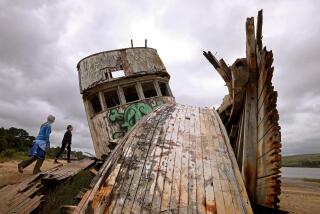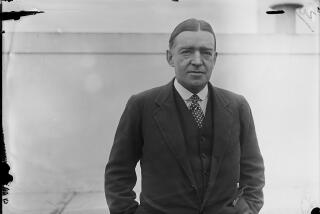Sunken Ship Is a Time Capsule From 1776
Outgunned and outmanned by a British fleet in the dismal fall of 1776, a small group of gunboats under the command of Benedict Arnold fought a delaying action in Lake Champlain.
Although the British won the battle and all but one of the American ships was sunk or scuttled, Arnoldâs fierce resistance and the time-consuming preparations it forced upon the British delayed a massive invasion by British land forces until the following year.
That postponement allowed the colonial forces to regroup and prepare for the decisive battle at Saratoga, N.Y., in 1777, which has been characterized as the âturning point of the American Revolution.â Recently, a marine archeologist from Vermont provided a dramatic new link to that stirring and gallant episode.
Art Cohn of the Lake Champlain Maritime Museum in Vergennes, Vt., revealed that his team had discovered one of Arnoldâs gunboats sitting upright on the bottom of the lake in pristine condition, its 50-foot mast virtually intact and its cannon poised to repel invaders.
The boat, whose name is not yet known, should provide valuable new information about marine technology during one of the most crucial periods of American history.
âThis is a fully intact, three-dimensional, full-scale time capsule back to 1776 and the struggle for American independence,â Cohn said. âItâs an extraordinary reminder of that time period and a valuable icon for American history.â
âThis could prove to be the most significant maritime discovery in America in the last half-century,â said naval historian Philip Lundeberg of the Smithsonian Institutionâs American History Museum. âThe apparently excellent condition of the gunboat is highly unusual for an artifact this old and is one of the reasons the discovery is so significant.â
Cohn has not revealed the exact location of the boat and, for at least the time being, the submerged shipwreck will remain where it is. The museum will work with the Navy and the states of New York and Vermont to decide whether to leave it at the site or to raise, conserve and exhibit it.
For Arnoldâs part, the battle was a last hurrah in terms of heroism. Three years later, in 1780, newly married and strapped for cash to maintain an extravagant lifestyle, Arnold began providing information to the British and eventually joined British forces as a brigadier general, becoming the most famous traitor in American history. He lived in England and Canada before his death in 1801.
*
The discovery of the boat was prompted by an environmental threat posed by the rapid spread of zebra mussels in the lake, a 115-mile-long stretch of water along the New York-Vermont border.
The mussels, accidentally imported into the lake from abroad more than two decades ago, encrust and damage anything in the water and researchers feared they would irreversibly damage the lakeâs collection of known and unknown underwater shipwrecks. Because of the many naval battles fought on the lake during the French and Indian War, the Revolutionary War and the War of 1812, as well as the large amount of maritime commerce conducted there, Lake Champlain contains one of the best-preserved collections of historic shipwrecks in North America.
Beginning last year, Cohn, Fred Fayette and Peter Barranco of the museum and geologists Patricia Manley and Tom Manley of Middlebury College in Vermont began a lake-wide sonar survey looking for shipwrecks. In 1996, they surveyed 40 square miles and found 10 vessels.
During the first week of the 1997 survey last month, they found a promising sonar contact. Cohn made one dive to explore it.
Wearing a dry suit in the icy cold water, Cohn swam to the deep spot. âAs soon as I saw it, I knew where I was and that it was a revolutionary-era gunboat,â he said. âThere was a voice screaming in my head, âOh my God, this is the gunboat! Benedict Arnold probably walked on this deck.â â
âThe first thing I saw was the mast partner, a structural support for the mast,â he said. Then he spied the mast. âAfter 221 years, it still stood full height, upright, in normal sailing position. The hull itself was completely intact up to the rail, with very little deteriorationâ but a little rust.
Cohn said he swam once around the 54-foot vessel. âThe rudder was still there. The tiller bar appeared to be gone, but a number of the stanchions were still in place. The most dramatic view was in the bow area, where the bow cannon is still in its original location.â He attributes the remarkable preservation to the cold, dark, airless water at the site.
Cohn is still the only person who has dived to the wreck. But using a specially designed remote-operated vehicle, a team from Benthos Inc. of North Falmouth, Mass., surveyed the site, taking several hours of videotapes and hundreds of photos.
The newly discovered boat played a key role in the early years of the Revolutionary War. American forces had captured Lake Champlain in 1775 and used it to invade British Canada. The failure of that invasion left a 10,000-man British force poised to invade the heart of the colonies. Defending against this threat were forts at Ticonderoga and Mt. Independence and a small fleet of 15 warships led by the young Arnold. That fleet included eight gunboats: the Philadelphia, the New Haven, the Providence, the Boston, the Spitfire, the Connecticut, the Jersey and the New York.
On Oct. 11, 1776, Arnoldâs forces engaged the British in a five-hour cannon battle now known as the Battle of Valcour Island. The American schooner Royal Savage and the Philadelphia were lost, and 10% of Arnoldâs men were killed or wounded. (The Philadelphia was raised in 1935 and placed on display at the Smithsonian.)
By nightfall, the British had the Americansâ escape blocked, but Arnold and his officers concocted a daring nighttime retreat. Guided by a shrouded light in the stern of each vessel and with oars wrapped in greased rags to muffle the noise, they quietly rowed past the British.
The next morning found Arnold struggling south with a frustrated British fleet in hot pursuit. On Oct. 13, they caught the rearmost American vessel and engaged in a second battle. This hours-long encounter ended when Arnold scuttled five vessels to prevent their capture in what has become known as Arnoldâs Bay in Panton, Vt. Arnold and his men escaped overland to Ft. Ticonderoga.
Only four of the original 15 ships, including the gunboat New York, made it back to Ticonderoga. The Jersey was captured by the British.
The newly discovered boat is thus one of the other five, and Cohn hopes to puzzle out its identity. âThatâs one of those wonderful little historical mysteries that we hope to solve,â he said.
(BEGIN TEXT OF INFOBOX / INFOGRAPHIC)
An Icon From American History
Using sonar to survey Lake Champlain, geologists and other researchers have discovered a gunboat scuttled in 1776 under the command of Benedict Arnold during a Revolutionary War battle against the superior British fleet. He later turned traitor.
The discovery was prompted by an environmental threat posed by the spread of zebra mussels in the lake. The mussels, below, encrust and damage anything in the water. Researchers feared they would irreversibly damage one of the best-preserved collections of historic shipwrecks in North America.
Benedict Arnoldâs Gunboat
The shipwreck was found sitting upright on the bottom of the lake in pristine condition.
Sources: Lake Champlain Maritime Museum, AP
More to Read
Sign up for Essential California
The most important California stories and recommendations in your inbox every morning.
You may occasionally receive promotional content from the Los Angeles Times.










